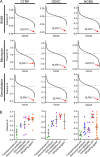Integrated pan-cancer gene expression and drug sensitivity analysis reveals SLFN11 mRNA as a solid tumor biomarker predictive of sensitivity to DNA-damaging chemotherapy
- PMID: 31682620
- PMCID: PMC6827986
- DOI: 10.1371/journal.pone.0224267
Integrated pan-cancer gene expression and drug sensitivity analysis reveals SLFN11 mRNA as a solid tumor biomarker predictive of sensitivity to DNA-damaging chemotherapy
Abstract
Background: Precision oncology seeks to integrate multiple layers of data from a patient's cancer to effectively tailor therapy. Conventional chemotherapies are sometimes effective but accompanied by adverse events, warranting the identification of a biomarker of chemosensitivity.
Objective: Identify an mRNA biomarker that predicts chemosensitivity across solid tumor subtypes.
Methods: We performed a pan-solid tumor analysis integrating gene expression and drug sensitivity profiles from 3 cancer cell line datasets to identify transcripts correlated with sensitivity to a panel of chemotherapeutics. We then tested the ability of an mRNA biomarker to predictive clinical outcomes in cohorts of patients with breast, lung, or ovarian cancer.
Results: Expression levels of several mRNA transcripts were significantly correlated with sensitivity or resistance chemotherapeutics in cancer cell line datasets. The only mRNA transcript significantly correlated with sensitization to multiple classes of DNA-damaging chemotherapeutics in all 3 cell line datasets was encoded by Schlafen Family Member 11 (SLFN11). Analyses of multiple breast, lung, and ovarian cancer patient cohorts treated with chemotherapy confirmed SLFN11 mRNA expression as a predictive biomarker of longer overall survival and improved tumor response.
Conclusions: Tumor SLFN11 mRNA expression is a biomarker of sensitivity to an array of DNA-damaging chemotherapeutics across solid tumor subtypes.
Conflict of interest statement
The authors have declared that no competing interests exist.
Figures




References
Publication types
MeSH terms
Substances
Grants and funding
LinkOut - more resources
Full Text Sources

